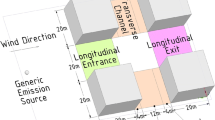Abstract
In the present study, an underfloor air distribution (UFAD) system with a circular swirl diffuser was simulated in an office room using a three-dimensional model when thermal sources were present in the room. An Eulerian-Lagrangian model was used to predict the characteristics of air and particle phases. In the Lagrangian particle model, the effects of drag, lift, Brownian, and thermophoresis forces were considered. The results showed that the circular swirl diffuser has better airflow and thermal conditions compared with the circular direct diffusers. It was also shown that the studied UFAD system provides good thermal comfort condition. The local and mean normalized particle concentrations in different heights of the room were found reasonable, and the particle removal efficiency was between 55 and 65% for all the particle sizes. The results also showed that the large particles due to their large weight stayed in lower heights of the room and deposited on the floor. The particle concentration in the breathing zone of manikins was also investigated, and it showed that though the manikins seated close to inlet registers have appropriate thermal comfort, they encounter the highest particle concentration in their breathing zone.



















Similar content being viewed by others

References
Ansaripour M, Abdolzadeh M, Sargazizadeh (2016) Computational modeling of particle transport and distribution emitted from a Laserjet printer in a ventilated room with different ventilation configurations. Appl Therm Eng 103:920–933
Chaves B, Leite C 2006 Analysis of thermal comfort in an office environment with under floor air supply in a tropical climate. American Society of Heating, Refrigerating and Air-Conditioning Engineers Published in HVAC&R Research, April , Vol 12, No. 2
Coelho Leite B, Tribess A (2005) Analysis of thermal comfort in an office environment with under floor air supply in a tropical climate. HVAC&R Research 12(2):215–229
Davidson L, Nielsen PV, Sveningsson A (2003) Modification of the V2 F model for computing the flow in a 3D wall jet. Turbulence Heat and Mass Transfer 4:577–584
Dehghan M, Abdolzadeh M (2018) Comparison study on air flow and particle dispersion in a typical room with floor, skirt boarding, and radiator heating systems. Build Environ 133:161–177
Fan Y, Li X, Yan Y, Tu J (2017) Overall performance evaluation of underfloor air distribution system with different heights of return vents. Energy and Buildings 147:176–187
Ho S , Rosario L, Rahman M 2011 Comparison of under floor and overhead air distribution systems in an office environment, Building and Envoirenment, Vol 46, 1415–1427
Holmberg S, Chen Q (2004) Air flow and particle control with different ventilation systems in a classroom. Indoor Air 13:200–204
Lai AC, Chen F (2007) Comparison of a new Eulerian model with a modified Lagrangian approach for particle distribution and deposition indoors. Atmos Environ 41(25):5249–5256
Li A, Ahmadi G (1992) Dispersion and deposition of spherical particles from point sources in turbulent channel flow. Aerosol Sci Technol 16:209–226
Li X, Inthavong K, Ge Q, Tu J (2013) Numerical investigation of particle transport and inhalation using standing thermal manikins. Build Environ 60:116–125
Lien F, Kalitzin G (2001) Computations of transonic flow with the v2-f turbulence model. Int J Heat Fluid Flow 22:53–61
Pereira ML, Graudenz G, Tribess AL, Morawska (2009) Determination of particle concentration in the breathing zone for four different types of office ventilation system. Build Environ 44:904–911
Pustelnik M, Tribess A, Evaluation of environment with underfloor air supply using cfd, Proceedings of the 11th Brazilian Congress of Thermal Sciences and Engineering ENCIT 2006 Braz. Soc. of Mechanical Sciences and Engineering ABCM, Curitiba, Brazil, Dec 2006, 5–8
Tian G, Ahmadi (2007) Particle deposition in turbulent duct flows–comparisons of different model predictions. J Aero Sci 38:377–397
Yau H, Poh KS, Badarudin A (2018a) An investigation of thermal environment of an existing UFAD system in a high-rise office building in the tropics. J Environ Health Sci Eng 16(2):313–322
Yau YH, Poh KS, Badarudin A (2018b) A numerical airflow pattern study of a floor swirl diffuser for UFAD system. Energy and Buildings 158:525–535
Yu BH, Seo B-M, Hong SH, Sanghun K, Ho YL (2018) Influences of different operational configurations on combined effects of room air stratification and thermal decay in UFAD system. Energy and Buildings 176:262–274
Zhang Z, Chen Q (2007) Comparison of the Eulerian and Lagrangian methods for predicting particle transport in enclosed spaces. Atmos Environ, 41:5236–5248
Zhang Z, Zhang W, Zhai Z, Chen Q (2007) Evaluation of various turbulence models in predicting airflow and turbulence in enclosed environments by CFD: part-2: comparison with experimental data from literature. HVAC &R Research. 13(6)
Zhang K, Zhang X, Li S (2016) Simplified model for desired airflow rate in underfloor air distribution (UFAD) systems. Appl Therm Eng 93:244–250
Zhong K, Yang X, Kang Y (2010) Effects of ventilation strategies and source locations on indoor particle deposition. Building and Environment 45:655–662
Zhou Y, Deng Y, Wu P, Cao S (2017) The effects of ventilation and floor heating systems on the dispersion and deposition of fine particles in an enclosed environment. Building and Environment 125:192–205
Author information
Authors and Affiliations
Corresponding author
Additional information
Responsible editor: Marcus Schulz
Publisher’s note
Springer Nature remains neutral with regard to jurisdictional claims in published maps and institutional affiliations.
Rights and permissions
About this article
Cite this article
Abdolzadeh, M., Alimolaei, E. & Pustelnik, M. Numerical simulation of airflow and particle distributions with floor circular swirl diffuser for underfloor air distribution system in an office environment. Environ Sci Pollut Res 26, 24552–24569 (2019). https://doi.org/10.1007/s11356-019-05651-8
Received:
Accepted:
Published:
Issue Date:
DOI: https://doi.org/10.1007/s11356-019-05651-8



